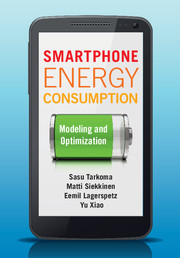Book contents
- Frontmatter
- Contents
- Preface
- List of abbreviations
- Part I Understanding energy consumption
- 1 Introduction
- 2 Energy and power primer
- 3 Smartphone batteries
- 4 Energy measurement
- 5 On human behavior and energy efficiency
- Part II Energy management and conservation
- Part III Advanced energy optimization
- Appendix A An energy profile application
- Index
- References
3 - Smartphone batteries
from Part I - Understanding energy consumption
Published online by Cambridge University Press: 05 August 2014
- Frontmatter
- Contents
- Preface
- List of abbreviations
- Part I Understanding energy consumption
- 1 Introduction
- 2 Energy and power primer
- 3 Smartphone batteries
- 4 Energy measurement
- 5 On human behavior and energy efficiency
- Part II Energy management and conservation
- Part III Advanced energy optimization
- Appendix A An energy profile application
- Index
- References
Summary
In this chapter we give an overview of smartphone batteries and their modeling. Battery models are important when the remaining battery capacity needs to be estimated. In this chapter, we give an overview of smartphone Li-Po batteries, their static and dynamic parameters and characteristics, and charging technology, and then consider techniques for assessing and modeling a battery SOC.
Overview
Figure 3.1 presents an overview of the Li-Ion battery charging and discharging process. Current is carried by lithium ions (Li+) that move from negative (anode) to positive (cathode) electrodes during discharging. The lithium ions move in the reverse direction when charging the battery. The ions move through the non-aqueous electrolyte and the separator. Applying a charge places the battery in a closed-circuit voltage, in which the voltage behavior is set by the internal battery resistance. Charging and discharging distorts the battery and it can take up to 24 hours for the battery to stabilize.
Battery life is proportional to the active reaction sites across the cathode. When the discharge current is low, inactive reaction sites are uniformly distributed over the volume of the cathode. When the discharge current is high, the volume of inactive sites at the outer surface of the cathode is large, causing active sites to become unreachable. As a consequence, the battery capacity is reduced at high discharge rates. When a high current is drawn from the battery, the diffusion rate cannot match the rate at which ions are being absorbed at the cathode.
- Type
- Chapter
- Information
- Smartphone Energy ConsumptionModeling and Optimization, pp. 36 - 58Publisher: Cambridge University PressPrint publication year: 2014



